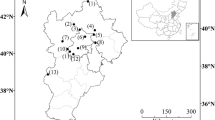Abstract
Background and Aim
An accurate estimation of biogenic emissions of VOC (volatile organic compounds) is necessary for better understanding a series of current environmental problems such as summertime smog and global climate change. However, very limited studies have been reported on such emissions in China. The aim of this paper is to present an estimate of biogenic VOC emissions during summertime in China, and discuss its uncertainties and potential areas for further investigations.
Materials and Methods
This study was mainly based on field data and related research available so far in China and abroad, including distributions of land use and vegetations, biomass densities and emission potentials. VOC were grouped into isoprene, monoterpenes and other VOC (OVOC). Emission potentials of forests were determined for 22 genera or species, and then assigned to 33 forest ecosystems. The NCEP/NCAR reanalysis database was used as standard environmental conditions. A typical summertime of July 1999 was chosen for detailed calculations.
Results and Discussion
The biogenic VOC emissions in China in July were estimated to be 2.3×1012gC, with 42% as isoprene, 19% as monoterpenes and 39% as OVOC. About 77.3% of the emissions are generated from forests and woodlands. The averaged emission intensity was 4.11 mgC m-2 hr-1 for forests and 1.12 mgC m-2 hr-1 for all types of vegetations in China during the summertime. The uncertainty in the results arose from both the data and the assumptions used in the extrapolations. Generally, uncertainty in the field measurements is relatively small. A large part of the uncertainty mainly comes from the taxonomic method to assign emission potentials to unmeasured species, while the ARGR method serves to estimate leaf biomass and the emission algorithms to describe light and temperature dependence.
Conclusions
This study describes a picture of the biogenic VOC emissions during summertime in China. Due to the uneven spatial and temporal distributions, biogenic VOC emissions may play an important role in the tropospheric chemistry during summertime.
Recommendations and Perspective
Further investigations are needed to reduce uncertainties involved in the related factors such as emission potentials, leaf biomass, species distribution as well as the mechanisms of the emission activities. Besides ground measurements, attention should also be placed on other techniques such as remote-sensing and dynamic modeling. These new approaches, combined with ground measurements as basic database for calibration and evaluation, can hopefully provide more comprehensive information in the research of this field.
Similar content being viewed by others
Author information
Authors and Affiliations
Corresponding author
Rights and permissions
About this article
Cite this article
Wang, Q., Han, Z., Wang, T. et al. An Estimate of Biogenic Emissions of Volatile Organic Compounds during Summertime in China (7 pp). Env Sci Poll Res Int 14 (Suppl 1), 69–75 (2007). https://doi.org/10.1065/espr2007.02.376
Received:
Accepted:
Published:
Issue Date:
DOI: https://doi.org/10.1065/espr2007.02.376




